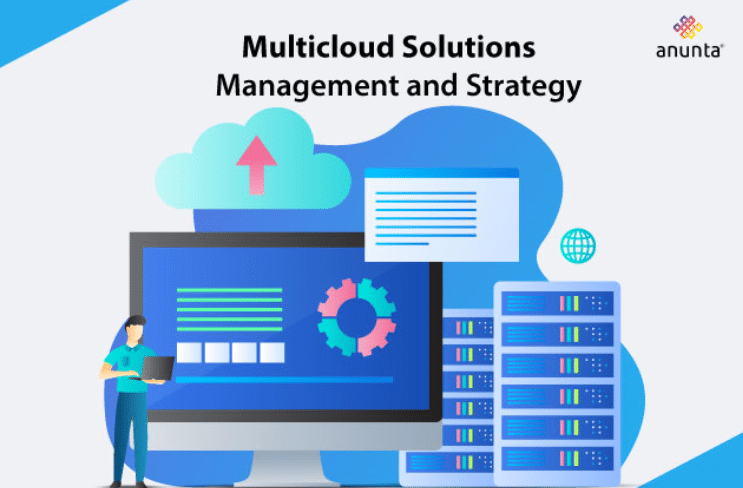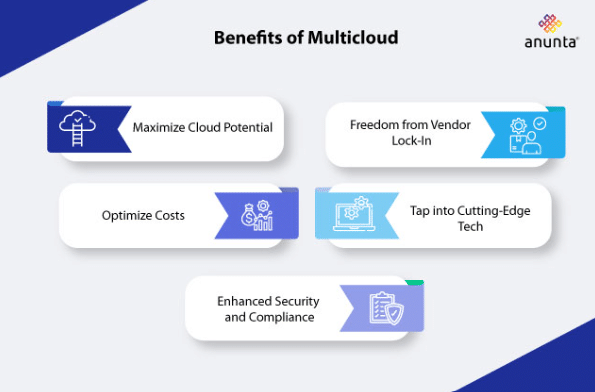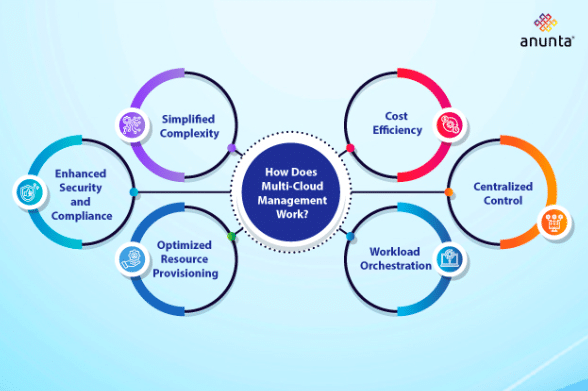
Many organizations have shifted from relying exclusively on a single cloud service provider (CSP) to adopting multiple providers in recent years. Key motivations for this transition include reducing reliance on one CSP, avoiding vendor lock-in, and enhancing operational flexibility.
Current trends show that organizations leverage a combination of cloud providers to capitalize on cost savings and select the best-in-class services for various applications, teams, or departments.
However, managing multi-cloud environments has become a significant challenge. This blog will explore what Multi-Cloud Management entails and its benefits.
Multi-cloud management involves using tools and processes that enable businesses to oversee and safeguard their applications and workloads across several public cloud platforms. Ideally, these solutions offer IT teams a unified interface for managing various cloud environments, supporting platforms like AWS and Azure and modern tools like Kubernetes.
Today, most organizations rely on more than one public cloud provider. This strategy reduces vendor lock-in, leverages each provider’s unique strengths, and optimizes cloud utilization and costs. However, as the number of cloud providers increases, so does the complexity of managing them. Multi-cloud management solutions aim to simplify this by offering a centralized platform that integrates with other management tools.
Containers and Kubernetes are key enablers of multi-cloud management. Containers package applications with their dependencies in a lightweight format, making them portable across different clouds. Kubernetes then helps in the effective management, deployment, and automation of these containers.
Many multi-cloud management platforms also offer self-service capabilities, allowing developers to select the most suitable cloud environment for their applications. Some solutions provide migration services and disaster recovery options to ensure business continuity.
Adopting multicloud services allows your organization to enhance IT agility and flexibility. Here are some of the key benefits that come with a multicloud approach:

Multicloud empowers you to select from a range of cloud vendors, tailoring features and capabilities to optimize your workloads. This flexibility ensures the best fit for performance, speed, security, geographical needs, and compliance demands.
With a multicloud strategy, you’re free to build anywhere with agility. No longer confined to a single provider, you can select the best solution for your business, reducing dependency issues like cost, interoperability, and data constraints.
Multicloud helps control IT expenses by letting you choose public clouds that minimize overhead. You can scale resources up or down as needed, lowering your total cost of ownership while finding the best price-performance balance across various providers.
As cloud vendors roll out innovative services, a multicloud approach allows you to adopt the latest technologies without being restricted by a single provider, enhancing your offerings with the most advanced tools.
Multicloud lets you consistently implement security measures and meet regulatory requirements across all workloads, ensuring protection and compliance no matter the service, vendor, or environment.
Multi-cloud management streamlines the coordination of resources, workloads, and services across public, private, and on-premises clouds. Here’s how it works:

Simplified Complexity: Managing different cloud platforms, each with its interfaces, APIs, and tools, can be overwhelming. Multi-cloud management offers a unified platform that simplifies administration by consolidating everything into one manageable location.
Cost Efficiency: Tracking spending across multiple cloud providers can be challenging, leading to missed opportunities for savings. Multi-cloud management tools provide cost visibility and analytics, helping identify the most cost-effective choices among providers.
Enhanced Security and Compliance: It is difficult to ensure consistent security measures and meet regulatory requirements across various cloud environments. Multi-cloud management tools help enforce security policies and automate compliance tasks, maintaining uniformity across all clouds.
Centralized Control: These tools centralize the management of resources and workloads across different cloud platforms, allowing administrators to monitor and manage everything from one dashboard, improving operational efficiency and overall visibility.
Optimized Resource Provisioning: Multi-cloud management tools facilitate virtual machines, storage, and network provisioning across clouds. This enables administrators to maximize resource allocation and performance based on workloads and policies.
Workload Orchestration: These platforms manage diverse workloads across cloud environments, handling allocation, scaling, and lifecycle management to ensure consistent performance and availability, regardless of the underlying infrastructure.
While a multi-cloud approach offers numerous advantages, it also presents challenges that can be tough for organizations to manage. Common hurdles include heightened complexity in managing multiple cloud environments, ensuring uniform security, seamless software integration, and maintaining consistent performance and reliability across different clouds.
Aligning a multi-cloud strategy with business goals, development objectives, and any architectural limitations of existing systems is crucial for effectively implementing it. Start by crafting a clear vision statement that details why you’re transitioning to a multi-cloud setup, the key metrics you aim to optimize, and your long-term plans for cloud adoption.
Once you’ve defined your goals, you can develop a comprehensive plan that covers workload assessment, prioritization, selection of appropriate cloud environments, and the technologies, architecture patterns, and network designs that best suit your needs.
At Anunta, we excel in multi-cloud management by providing a centralized platform that integrates various cloud environments into a unified system. Our services include real-time monitoring, automated optimization, and proactive cost management to enhance performance and reduce expenses.
We ensure seamless data flow and security across clouds, leveraging advanced tools to provide comprehensive visibility and control. With Anunta, businesses benefit from tailored strategies that align multi-cloud resources with their specific needs, driving operational efficiency and maximizing the value of their cloud investments.
Q: What is Multi-Cloud Management?
A: Multi-cloud management involves using tools and processes to oversee and protect applications and workloads across multiple cloud platforms. It simplifies management by providing a unified interface for various clouds, reducing complexity and optimizing operations.
Q: What are the benefits of adopting a multi-cloud strategy?
A: A multi-cloud strategy maximizes cloud potential, avoids vendor lock-in, optimizes costs, taps into the latest technologies, and enhances security and compliance. It allows organizations to leverage the best features of different cloud providers.
Q: How does Multi-Cloud Management work?
A: Multi-cloud management simplifies administration by consolidating resources into a single platform, providing cost visibility, ensuring security and compliance, centralizing control, and optimizing resource provisioning and workload orchestration across different cloud environments.
Q: What are the challenges of Multi-Cloud Management?
A: Challenges include managing complexity, ensuring consistent security, seamlessly integrating software, and maintaining performance across different clouds. It requires aligning strategies with business goals and addressing architectural limitations.
Q: How does Anunta assist with Multi-Cloud Management?
A: Anunta offers a centralized platform for managing multiple cloud environments. It provides real-time monitoring, automated optimization, proactive cost management, seamless data flow, and security and aligns resources with specific business needs for enhanced efficiency.
Research Review with Anunta’s CTO | Jan 14 | 12PM PST/3PM EST